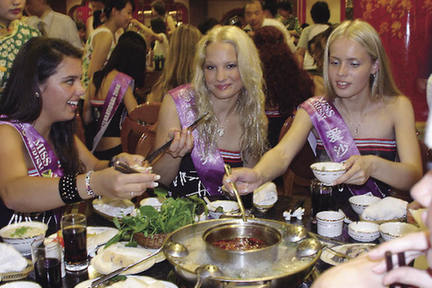"Spicy" is usually the first impression diners have of Sichuan cuisine, but actually authentic Sichuan food should be salty. Chongqing dishes still maintain the area's original salty taste, while Chengdu cuisine has evolved over hundreds of years into today's well known spicy fare.
Located in a basin in west China, Sichuan is mild and moist in climate, with little difference between day and night temperatures. Ancient people in the area had to pickle food with salt to preserve it. Spice was then added to increase its delicacy.
Another explanation for the local food's spicy nature is that pungent seasoning helped cover strong smells. Beef and mutton have long been a major part of Chinese people's diets, so strong seasoning was commonly used to remove the odors produced by these meats. With the evolution of agriculture and poultry breeding, the importance of covering unpleasant aromas has faded. Sichuan's damp climate remains an issue however. Gastronomists believe eating chili can help drive away the "chillness and moisture" that characterizes the local air by accelerating blood circulation and warding off damp vapors. Spice also stimulates one's system, making it an "effective medicine to cure depression" in a province where winters are often clammy and foggy.
 |
|
Miss Tourism International contenders taste hotpot in Chongqing. |
Chengdu cuisine is the center of Sichuan cooking, and has become a synonym for luxury. This is evident not only in the sumptuous decoration of local restaurants, but also in the city's food, which has become known as "New Sichuan cuisine." The best area to sample the latest in Chengdu cooking is Xiyanxian. The Chengdu hot pot on Qintai Road is also considered very authentic, while the Chuandonglaojia Restaurant near Laochengguan Road is well known for its more traditional Sichuan fare.
Twice-cooked pork is a must-eat home-style Chengdu dish that embodies the essence of Sichuan cuisine. The famous dish derives from ancient offerings. Pork placed on altars as an offering was usually lightly cooked, and after the ceremony it was unwise to stew the cold meat again. Instead, people would quick-fry it, stirring the meat with garlic shoots. Hence the name twice-cooked pork.
To make genuine twice-cooked pork you must use rump meat, green garlic shoots, broad beans from Pixian County, fermented soybeans and 10 other supplementary materials. The size of the pork slices is also important. It should be three cm long and 0.3 cm wide. The meat should be stewed until it is medium rare. It is also important to get the temperature of the oil and seasonings just right during the stir-frying to achieve the perfect color, aroma and taste.

